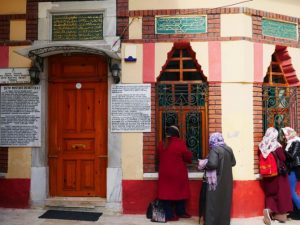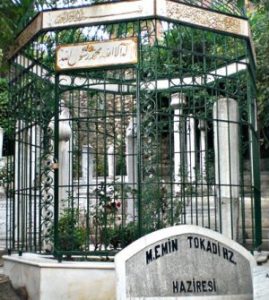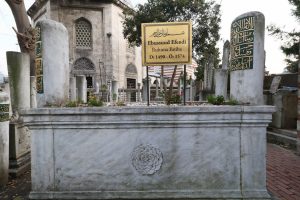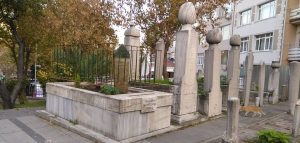For centuries, Istanbul was not only the capital of the Ottoman Empire, but also its spiritual center. Hundreds of Sufi shrines on the Bosphorus serve as spiritual schools and gathering places.
Visiting Sufi shrines is an important religious practice of popular Islam. Over the centuries, holy shrines have attracted believers from all social classes, who have come to pray to Allah Almighty by mentioning the name of a Waliyy or a great scholar so that Allah may respond to their Du^a’ in honor of the one who seeks them, whether women hoping for pregnancy, businessmen seeking better deeds, or statesmen facing difficult decisions.
Sheikh Yahya Effendi
The shrines of the sheikhs of Istanbul – the sheikhs of Sufism in the past centuries – are visited by the city’s residents and tourists to this day. One of the most important shrines in the European part of the city is the shrine of Yahya Effendi (1494-1569), a contemporary of Sultan Suleiman the Magnificent.
After Yahya Effendi obtained permission to teach from his sheikh, he settled in a garden in the Besiktas district. Here he pursued a spiritual life and received guests who seek his blessing. Today, many visit Yahya Efendi Mausoleum, not least because of its stunning view of the Bosphorus.
The guardian’s turban is placed over his sarcophagus, as seen here in the mausoleum of Yahya Effendi. The turban is used as a symbol to indicate the spiritual rank of the sheikh, and its colors and the way it is wrapped differ between the different Sufi orders.
The Sufi shrine is usually attached to a mosque so that visitors can also perform prayers. Many of the shrines have been elaborately restored in the past years.
Sheikh Mustafa Dwati
The shrine of Mustafa Dawati, a 16th-century Sufi sheikh, is located in a popular market in the Asian region of Uskudar. Many visit the shrine while shopping or on their way to work.
Sheikh Mahmoud Aziz Hudai
Uskudar region is famous for its large number of shrines and mosques. Many streets and neighborhoods are also named after famous Sufi sheikhs or dervishes.

The mausoleum of the great patron saint of Turkey, Sheikh Aziz Mahmud Hudai (1541-1628) is located in the center of Uskudar. Hudayi, the founder of the Jaluti Order, is also known as a poet who wrote Sufi poetry in the Ottoman language. His tomb complex includes a school for memorizing the Qur’an and a library.
The tombs of relatives, students and devotees, as well as generations of custodians of the shrine, are frequently found next to the shrine of the Sufi Sheikh. It is also appreciated by visitors to the shrine.
Sheikh Muhammad Amin Touqadi
He is a famous Waliyy, a contemporary of Sultan Mahmud I. This righteous worshipper was born in the Turkish city of Tuqad. He moved to Istanbul to learn the sciences of Sharia and calligraphy, and he was a skilled calligrapher. The events took him to Mecca, where he stayed for a period of time and was taught by its sheikhs before returning again to Istanbul, where he stayed and died. His tomb is approximately 500 meters from the Mosque of Muhammad Al-Fateh, may God be pleased with him.

Sheikh of Islam Imam Abu Al-Su^oud Effendi
Muhammad Muhyi al-Din Muhammad ibn Mustafa al-Imad, nicknamed Abu al-Saud Effendi, was one of the most famous sheikhs of Islam in the Ottoman Empire. He held the highest religious and scholarly position during the rule of three Ottoman sultans. As the Ottoman sultans did not dispense with the opinions and fatwas of the sheikhs of Islam, the fatwas of Abu Al-Saud Effendi contributed to making dangerous and fateful decisions in the Ottoman Empire.
Abu Al-Su^oud grew up in the house of knowledge and Salah. His father, Muhyiddin Muhammad, was one of the scholars of his time, and one of the properties of the endowments of the corner that Sultan Bayezid II built for him in Istanbul. Abu Al-Saud was educated by his father and was fluent in Turkish, Arabic and Persian and wrote poetry and letters with them, and his books became famous in the Islamic world

When his father Muhyiddin died in 1514, he was offered to head his father’s zawiya, which had been built by Sultan Bayezid II, but he refused it. In 1516 he was appointed to the school of Ishak Pasha in the town of “Ain Gul” in Bursa. When he separated from her, he spent ten months teaching at the Daoud Pasha School in Istanbul, then he was appointed to the Ali Pasha School in Istanbul in 1521.
In 1528 he was appointed to the “Sahn Thaman” school, which was built by order of Sultan Muhammad Al-Fateh after the conquest of Constantinople in Al-Fateh College. It was named by that name because there were eight schools in it, and Abu Al-Saud remained there for five years until he was accepted in the judiciary in Bursa in the place of Sheikh Zada Hassan fetch me.
Then Abu Al-Saud Effendi was transferred from Bursa district to Constantinople district. After that, he was transferred to the military district in the place of “Fanani Zada Mohieddin Chalabi” and became Sheikh of Islam in 1545. He continued in this position for thirty years. Sultan Suleiman the Magnificent cared about his views and therefore appointed him as Mufti in the capital. He died and was buried in Istanbul, and his tomb is located in the Sultan Ayyub area in a cemetery adjacent to the Abu Ayyub Al-Ansari Mosque, may God be pleased with him.
Sheikh Mulla Guran – Al-Kourani

He is Ahmed bin Ismail bin Othman Al-Kurani Shihab Al-Din Al-Shafi’i (813 AH / 1410 – 893 AH / 1488). An interpreter of Kurdish origin, from the people of Shahrazur, in the Sulaymaniyah Governorate in Iraqi Kurdistan, where the Gurani Jaff tribes (Goran) are spread. He started poor and then rose to become the teacher of the sultans, and he was famous for being harsh on kings and advice to them. Sultan Murad bin Othman entrusted him with the education of his crown prince, Muhammad the Conqueror.
He died in 892 AH / 1488 AD, and he was born in 813 AH / 1410 AD. And his grave is in the locality of Fendekzade on a small hill.
Sunna Files Free Newsletter - اشترك في جريدتنا المجانية
Stay updated with our latest reports, news, designs, and more by subscribing to our newsletter! Delivered straight to your inbox twice a month, our newsletter keeps you in the loop with the most important updates from our website











